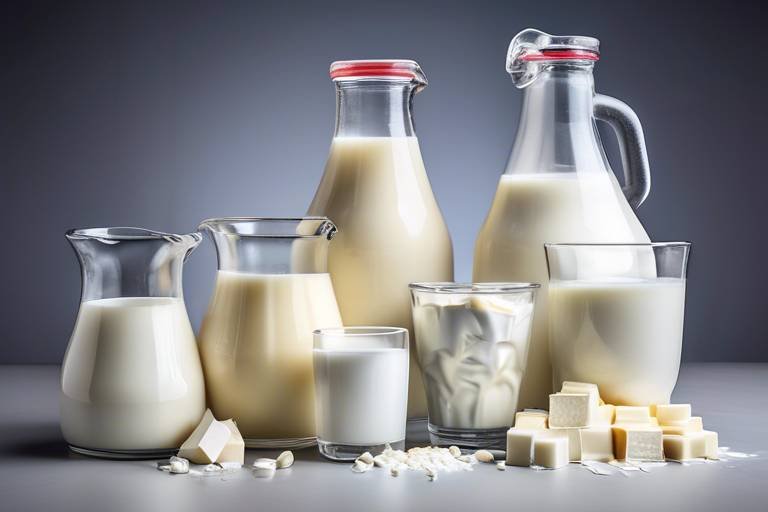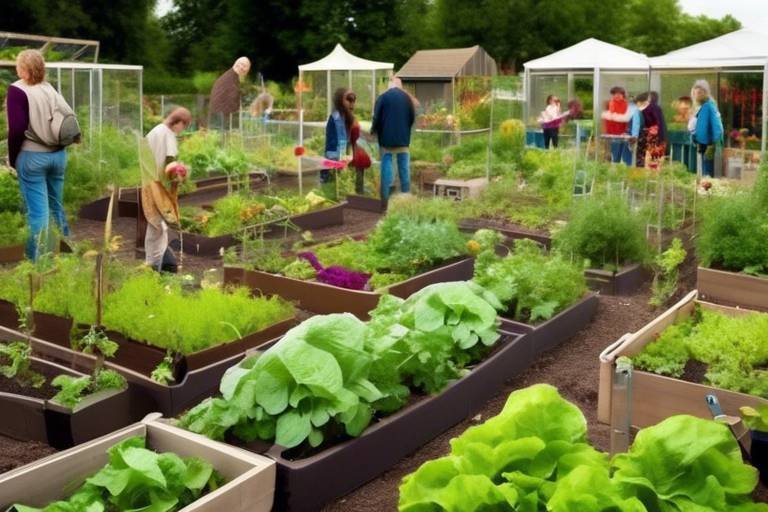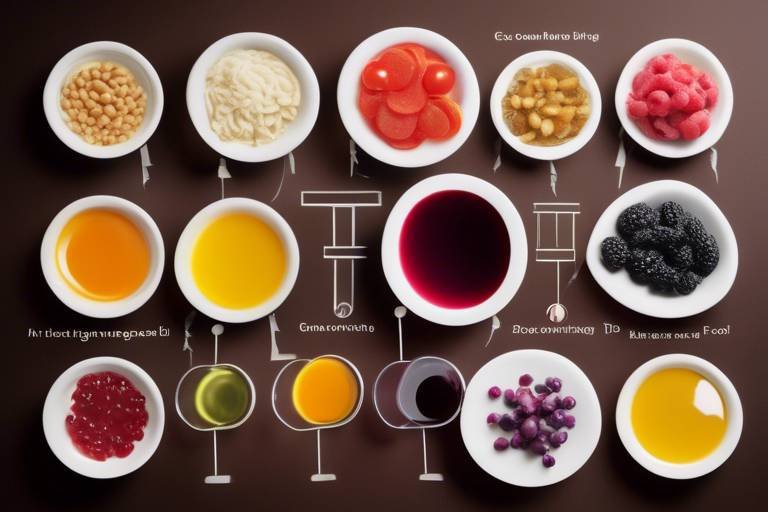The Chemistry of Fermentation in Everyday Foods
Fermentation is like magic happening right in our kitchens! It transforms simple ingredients into something extraordinary, enhancing flavors and adding a unique twist to our favorite foods. Imagine taking a plain piece of cabbage and, through the wonders of fermentation, turning it into tangy sauerkraut or crunchy kimchi. This process is not just about taste; it’s a complex biochemical dance involving microorganisms that work tirelessly to create delightful flavors and textures. In this article, we will explore the fascinating world of fermentation, diving deep into the chemical processes that make it possible, the role of microorganisms, and the incredible benefits that fermented foods offer to our health.
At its core, fermentation is a metabolic process that converts sugars into acids, gases, or alcohol using microorganisms such as bacteria, yeast, or molds. But what does this really mean? Think of it like a party where these tiny organisms break down sugars in an anaerobic environment (without oxygen), resulting in various by-products that contribute to the taste and preservation of food. The fundamental principles of fermentation hinge on several key factors:
- Microorganisms: The stars of the show, including yeast and bacteria.
- Substrates: The sugars and carbohydrates that these microorganisms feast on.
- Conditions: Temperature, pH, and oxygen levels all play crucial roles in the fermentation process.
Understanding these elements is essential for anyone looking to delve into the world of fermented foods, whether you're a home cook or a seasoned chef.
Microorganisms are the unsung heroes of fermentation. They come in various forms, each contributing uniquely to the flavor profiles and textures of our favorite foods. Yeast, particularly the species Saccharomyces cerevisiae, is famous for its role in baking and brewing. On the other hand, lactic acid bacteria are crucial for dairy products and pickled vegetables. These microorganisms not only enhance flavors but also help in preserving food, making it last longer and be more nutritious. Let’s take a closer look at their functions:
Yeast fermentation is a fascinating process that occurs when yeast consumes sugars and produces alcohol and carbon dioxide as by-products. This is particularly important in baking, brewing, and winemaking. For instance, when you bake bread, the carbon dioxide produced by yeast causes the dough to rise, creating that fluffy texture we all love. Similarly, in brewing beer, yeast transforms sugary malt into a refreshing beverage. This fermentation process is not just about the end product; it’s also about the journey and the intricate balance of flavors that develop along the way.
The journey of brewing beer is a meticulous process that begins with mashing grains to extract sugars. Once the sugars are dissolved, yeast is added, and fermentation begins. During this time, yeast works its magic, converting those sugars into alcohol and carbon dioxide, which contributes to the beer’s carbonation. The flavor profile of the beer is influenced by the type of yeast used, the grains selected, and even the fermentation temperature. It’s a beautiful blend of science and art, resulting in a drink that has been cherished for centuries.
In the world of baking, yeast fermentation is the secret ingredient that transforms simple dough into a delightful loaf of bread. As yeast ferments the sugars in the dough, it produces carbon dioxide, which gets trapped in the gluten structure, causing the dough to rise. This process not only gives bread its airy texture but also enhances its flavor. The longer the fermentation, the more complex the taste becomes, leading to that delicious crust and soft interior that we all crave.
While yeast gets a lot of attention, let’s not forget about the power of bacteria! Lactic acid bacteria are essential players in the fermentation of dairy products like yogurt and cheeses, as well as vegetables like sauerkraut and pickles. These bacteria thrive in environments with low oxygen and produce lactic acid, which not only preserves the food but also contributes to its tangy flavor. The health benefits of these fermented foods are also noteworthy, as they contain probiotics that support gut health and overall well-being.
Fermented foods are a treasure trove of health benefits! Regular consumption of these foods can lead to improved digestion, enhanced nutrient absorption, and a boost in your immune system. The probiotics found in fermented foods help balance the gut microbiome, which is essential for maintaining a healthy digestive system. Plus, they can even contribute to better mental health, as emerging research suggests a strong connection between gut health and mood. So, incorporating a variety of fermented foods into your diet is not just delicious; it’s a smart choice for your health!
Temperature plays a pivotal role in the fermentation process. It can significantly influence the activity of microorganisms, fermentation speed, and the overall quality of the final product. For example, warmer temperatures can speed up fermentation, while cooler temperatures slow it down. However, each type of fermentation has its own optimal temperature range to achieve the best results. Understanding these nuances can help you master the art of fermentation in your kitchen.
Here’s a quick breakdown of optimal temperature ranges for common types of fermentation:
| Type of Fermentation | Optimal Temperature (°C) |
|---|---|
| Bread Baking | 25-30 |
| Beer Brewing | 18-24 |
| Yogurt Making | 40-45 |
Fluctuations in temperature can lead to inconsistent fermentation results. For instance, if the temperature is too high, it can cause yeast to produce off-flavors, while too low temperatures can stall fermentation altogether. Maintaining stable conditions is crucial for achieving the desired flavor and texture in your fermented foods. So, keep an eye on that thermometer!
- What is fermentation? Fermentation is a metabolic process where microorganisms convert sugars into acids, gases, or alcohol.
- What are the benefits of eating fermented foods? Fermented foods offer numerous health benefits, including improved digestion, enhanced nutrient absorption, and a boost in gut health.
- Can I ferment foods at home? Absolutely! Many fermented foods can be made at home with simple ingredients and the right conditions.

The Basics of Fermentation
Fermentation is a magical transformation that occurs when microorganisms, such as yeast and bacteria, break down sugars and starches into simpler compounds. This process not only creates unique flavors but also extends the shelf life of various foods. At its core, fermentation is a biochemical reaction that requires specific conditions to thrive. Think of it as a culinary alchemy; it turns ordinary ingredients into extraordinary delights!
To understand fermentation, we need to dive into the biochemical processes that make it happen. The primary players in this process are microorganisms, which can be broadly categorized into two types: yeast and bacteria. These tiny organisms are like the unsung heroes of the kitchen, working behind the scenes to create everything from tangy yogurt to bubbly beer. But what exactly do they do?
When conditions are right—typically involving the right temperature, pH levels, and the presence of sugars—these microorganisms start to feast. For instance, yeast consumes sugar and produces alcohol and carbon dioxide as byproducts. This is why fermentation is not just a science; it’s also an art form! The balance of ingredients, the timing, and the environment all play crucial roles in determining the final product.
Fermentation can be classified into two main types: anaerobic (without oxygen) and aerobic (with oxygen). In anaerobic fermentation, yeast thrives in the absence of oxygen, leading to the production of alcohol. This is the process you see in brewing beer or making wine. On the other hand, aerobic fermentation, which occurs in the presence of oxygen, is common in the production of vinegar. Each type of fermentation has its unique flavor profile and uses.
To illustrate the complexity of fermentation, consider the following table that summarizes the key factors influencing this process:
| Factor | Effect on Fermentation |
|---|---|
| Temperature | Affects the rate of microbial activity; higher temperatures can speed up fermentation but may also produce off-flavors. |
| pH Level | Different microorganisms thrive at different pH levels, influencing flavor and texture. |
| Oxygen Availability | Determines whether anaerobic or aerobic fermentation occurs, affecting the end products. |
| Time | Longer fermentation can enhance flavors but may also lead to over-fermentation if not monitored. |
In conclusion, fermentation is a fascinating interplay of science and art, where microorganisms transform simple ingredients into complex flavors and textures. By understanding the basics of this process, we can appreciate the rich world of fermented foods that enhance our diets and tantalize our taste buds. So, the next time you enjoy a slice of sourdough bread or sip on a glass of kombucha, remember the incredible journey those ingredients underwent to become the delicious treats we love!
- What is fermentation? Fermentation is a metabolic process where microorganisms convert sugars into acids, gases, or alcohol under anaerobic or aerobic conditions.
- What are the benefits of fermented foods? Fermented foods are rich in probiotics, improve digestion, and enhance nutrient absorption.
- Can fermentation be done at home? Yes, many fermented foods like yogurt, sauerkraut, and kombucha can be easily made at home with the right ingredients and conditions.

Microorganisms in Fermentation
When you think about your favorite fermented foods, have you ever stopped to consider the tiny heroes behind the scenes? Microorganisms are the unsung champions of fermentation, playing a crucial role in transforming simple ingredients into complex, flavorful dishes. These microorganisms, primarily yeasts and bacteria, work their magic through biochemical processes that not only enhance flavors but also improve the nutritional profile of the food.
At the heart of fermentation are yeasts, particularly the species known as Saccharomyces cerevisiae. This little powerhouse is responsible for converting sugars into alcohol and carbon dioxide, which is essential in various culinary applications. For instance, in brewing beer, yeast ferments the sugars derived from malted grains, creating not just alcohol but also a plethora of flavors that define different beer styles. Similarly, in baking, yeast fermentation produces the carbon dioxide that makes bread rise, giving it that fluffy texture we all love.
On the other hand, bacteria, especially lactic acid bacteria, are vital in the fermentation of foods like yogurt, sauerkraut, and pickles. These bacteria thrive in environments rich in carbohydrates and sugars, converting them into lactic acid—a process that not only preserves the food but also gives it a tangy flavor. Imagine biting into a crisp pickle or a creamy yogurt; it's the lactic acid bacteria working tirelessly to create those distinct tastes and textures.
To better understand the roles of these microorganisms, let’s break it down:
| Microorganism Type | Key Function | Common Fermented Foods |
|---|---|---|
| Yeast | Converts sugars into alcohol and carbon dioxide | Beer, Wine, Bread |
| Lactic Acid Bacteria | Ferments sugars into lactic acid | Yogurt, Sauerkraut, Pickles |
The interaction between these microorganisms and the substrates they ferment is a fascinating dance of life. Each microorganism has its own preferences and tolerances. For example, while yeast thrives in an oxygen-rich environment, lactic acid bacteria prefer anaerobic conditions. This is why you’ll often find these microorganisms coexisting in fermented products, each contributing to the overall flavor and texture.
Moreover, the diversity of microorganisms involved in fermentation is astounding. Different strains of yeast and bacteria can produce a variety of flavors and textures, resulting in the unique characteristics of each fermented food. This is why homemade sauerkraut might taste different from store-bought versions, or why craft beers have such a wide range of flavor profiles. The art of fermentation is not just about the ingredients; it’s about the microorganisms that bring those ingredients to life.
In summary, the microorganisms involved in fermentation are not just participants; they are the stars of the show. Their intricate processes and interactions with food not only enhance flavors but also contribute to the health benefits associated with fermented foods. So, the next time you enjoy a delicious slice of sourdough bread or a refreshing glass of kombucha, take a moment to appreciate the tiny organisms that made it all possible!
Q: What is fermentation?
A: Fermentation is a metabolic process that converts sugars into acids, gases, or alcohol using microorganisms like yeast and bacteria.
Q: What are the health benefits of fermented foods?
A: Fermented foods are rich in probiotics, which can improve digestion, enhance nutrient absorption, and support gut health.
Q: Can I make fermented foods at home?
A: Absolutely! Many fermented foods, such as yogurt, sauerkraut, and kombucha, can be easily made at home with simple ingredients and the right microorganisms.

Yeast Fermentation
Yeast fermentation is a remarkable process that transforms simple sugars into complex flavors and delightful aromas. The star of this show is Saccharomyces cerevisiae, a type of yeast that has been utilized for centuries in various culinary traditions. Imagine a tiny microorganism working tirelessly, converting sugars into alcohol and carbon dioxide, which not only preserves food but also enriches it with unique characteristics. This process is not just about creation; it’s a dance of chemistry that has fascinated humans for ages.
When we think about yeast fermentation, two major applications come to mind: baking and brewing. In both cases, yeast plays a crucial role, but the processes and outcomes differ remarkably. For instance, in baking, yeast is responsible for making dough rise, creating that fluffy texture we all love in bread. It releases carbon dioxide as it consumes sugars, causing the dough to expand. On the flip side, in brewing, yeast ferments sugars into alcohol, giving us the delightful beverages we enjoy. This duality highlights the versatility of yeast and its importance in our everyday lives.
Let’s take a closer look at how yeast fermentation works in these two applications. In the brewing process, the journey begins with mashing grains, where the starches are converted into sugars. Once the sugar-rich liquid, known as wort, is prepared, yeast is added. This is where the magic happens! The yeast ferments the sugars, producing alcohol and carbon dioxide, which not only contributes to the drink's potency but also affects its flavor profile.
| Stage | Description |
|---|---|
| Mashing | Grains are soaked in hot water to convert starches into fermentable sugars. |
| Boiling | The wort is boiled, often with hops added for flavor and aroma. |
| Fermentation | Yeast is added to the cooled wort, where it converts sugars into alcohol and carbon dioxide. |
| Bottling | The beer is filtered and bottled, sometimes with additional sugar for carbonation. |
In baking, the process is somewhat similar but focuses on creating a leavened product. The yeast ferments the sugars present in the dough, producing carbon dioxide that gets trapped in the gluten structure, causing the dough to rise. This not only results in a light, airy texture but also enhances the flavor, giving bread that distinct taste we all crave. The longer the fermentation, the more complex the flavors become, which is why artisan breads often have a longer fermentation period.
It's fascinating to think about how these tiny organisms can have such a profound impact on our food and drink. Without yeast fermentation, we wouldn’t have beer, wine, or even the delicious sourdough bread that many of us adore. So, the next time you take a bite of a fresh loaf or sip on a cold brew, remember the little yeast cells that made it all possible!

Brewing Beer
Brewing beer is an ancient craft that combines art and science, and at the heart of this process lies the fascinating role of yeast fermentation. The journey of brewing begins with the selection of high-quality ingredients, primarily malted grains, hops, yeast, and water. Each ingredient contributes unique flavors and characteristics to the final product, making the brewing process as much about creativity as it is about chemistry.
Initially, the grains are mashed, a process that involves soaking them in hot water to activate enzymes that convert starches into fermentable sugars. This sugary liquid, known as wort, is then boiled with hops, which add bitterness and aroma to the beer. After boiling, the wort is cooled down, and yeast is introduced. This is where the magic happens! The yeast, particularly the species Saccharomyces cerevisiae, begins to consume the sugars present in the wort, producing alcohol and carbon dioxide as byproducts.
The fermentation phase is crucial, as it can last anywhere from a few days to several weeks, depending on the type of beer being brewed. During this time, the yeast not only ferments the sugars but also contributes to the beer's flavor profile through the production of various compounds such as esters and phenols. These compounds can impart fruity or spicy notes, adding complexity to the final taste.
Once fermentation is complete, the beer undergoes conditioning, where it matures and develops its flavors further. This step often involves additional hops, a process known as dry hopping, which enhances aroma without adding bitterness. Finally, the beer is filtered, carbonated, and packaged for enjoyment.
The entire brewing process can be summarized in the following steps:
- Mashing: Soaking grains in hot water to convert starches into sugars.
- Boiling: Adding hops to the wort and boiling to extract flavors.
- Fermentation: Introducing yeast to convert sugars into alcohol and carbon dioxide.
- Conditioning: Allowing the beer to mature and develop its flavors.
- Packaging: Filtering and bottling the beer for consumption.
In conclusion, brewing beer is a remarkable blend of tradition and science, where the fermentation process not only transforms simple ingredients into a beloved beverage but also showcases the incredible capabilities of yeast. Whether you’re sipping a hoppy IPA or a rich stout, take a moment to appreciate the complex journey that brought that beer to your glass!
- What is the primary role of yeast in brewing beer? Yeast ferments the sugars in the wort, producing alcohol and carbon dioxide, and contributes to the beer's flavor profile.
- How long does the fermentation process take? Fermentation can last from a few days to several weeks, depending on the type of beer being brewed.
- Can I brew beer at home? Absolutely! Homebrewing kits are widely available, allowing enthusiasts to explore the craft of brewing.

Baking Bread
Baking bread is not just a culinary skill; it’s a beautiful dance of chemistry and art that transforms simple ingredients into something magical. At the heart of this process is yeast fermentation, where yeast, primarily Saccharomyces cerevisiae, works its wonders. When you mix flour, water, and yeast, you’re not just combining ingredients; you’re setting the stage for a fascinating transformation. As the yeast consumes the sugars present in the flour, it produces carbon dioxide and alcohol, creating the bubbles that make your dough rise.
Have you ever wondered why freshly baked bread has that irresistible aroma? It’s all thanks to the complex chemical reactions happening during fermentation. As the yeast ferments, it not only produces gas but also contributes to the development of flavor compounds. These compounds are what give different types of bread their unique tastes—think of the difference between a sourdough and a baguette. The longer the fermentation, the more pronounced these flavors become, leading to a richer, deeper taste.
Now, let’s break down the bread-making process. It typically involves several key stages:
- Mixing: Combining flour, water, salt, and yeast to form a dough.
- Kneading: This is where the magic happens! Kneading develops gluten, which helps trap the carbon dioxide produced by the yeast, allowing the dough to rise.
- Fermentation: The dough is left to rest, giving the yeast time to work its magic. This can take anywhere from 30 minutes to several hours, depending on the type of bread.
- Baking: Finally, the dough is baked, and the heat kills the yeast, solidifying the structure and creating that delicious crust.
Understanding the role of temperature during this process is crucial. Yeast thrives in warm environments, typically around 75°F to 80°F (24°C to 27°C). If it’s too cold, the fermentation process slows down, and you might end up with dense, flat bread. On the other hand, if the temperature is too high, you risk killing the yeast, leading to a failed loaf. It’s a delicate balance that every baker must master.
Moreover, the type of flour you use can also impact the final product. Bread flour, with its higher protein content, is ideal for yeast bread because it develops more gluten, resulting in a chewier texture. In contrast, all-purpose flour can be used, but the bread may not rise as high or have the same texture. So, choosing the right ingredients is just as important as the fermentation process itself.
In conclusion, baking bread is a fascinating blend of science and creativity. The yeast fermentation process not only makes the dough rise but also enriches the flavor, texture, and aroma of the bread. So, the next time you enjoy a slice of warm, crusty bread, remember the tiny microorganisms that made it all possible, transforming humble ingredients into a delightful experience.
Q: What happens if I let my dough rise too long?
A: If you let your dough rise too long, the yeast may over-ferment, leading to a sour flavor and a collapsed structure. It's essential to keep an eye on the dough and perform the "poke test" to check its readiness.
Q: Can I use instant yeast instead of active dry yeast?
A: Yes, you can! Instant yeast can be mixed directly into the dry ingredients without needing to proof it in water first, making it a convenient option.
Q: Why is my bread dense?
A: Dense bread can result from several factors, including insufficient kneading, using the wrong type of flour, or not allowing the dough to rise adequately. Ensure you’re following the right steps for the best results.

Bacterial Fermentation
Bacterial fermentation is a captivating process that involves the action of various bacteria to convert sugars into acids, gases, or alcohol. This method not only transforms the basic ingredients but also enriches our diets with unique flavors and health benefits. One of the most notable groups of bacteria involved in fermentation is lactic acid bacteria (LAB), which includes species such as Lactobacillus and Streptococcus. These tiny powerhouses thrive in anaerobic conditions, meaning they can work their magic without oxygen, making them perfect for fermenting a variety of foods.
When you think of fermented foods, items like yogurt, sauerkraut, and pickles likely come to mind. Each of these foods undergoes a fascinating transformation due to bacterial fermentation. For instance, in yogurt production, LAB ferment lactose, the sugar found in milk, into lactic acid. This process not only thickens the milk but also gives yogurt its characteristic tangy flavor. Similarly, when cabbage is fermented to make sauerkraut, the natural sugars in the cabbage are converted into lactic acid, preserving the cabbage and enhancing its taste.
Beyond flavor, the health benefits of bacterial fermentation are remarkable. Regular consumption of fermented foods can lead to improved digestion and enhanced gut health, thanks to the presence of probiotics. These beneficial bacteria help maintain a balanced gut microbiome, which is crucial for overall health. Research has shown that incorporating fermented foods into your diet can lead to:
- Improved Digestion: Fermented foods can aid in breaking down food, making nutrients more accessible.
- Enhanced Nutrient Absorption: The fermentation process can increase the bioavailability of vitamins and minerals.
- Boosted Immune System: Probiotics found in fermented foods can help strengthen the immune response.
So, how do these bacteria work their magic? The fermentation process generally follows these steps:
| Step | Description |
|---|---|
| 1 | Bacteria are introduced to the food substrate (like milk or vegetables). |
| 2 | The bacteria consume sugars present in the substrate. |
| 3 | As a byproduct of sugar consumption, lactic acid is produced. |
| 4 | The increase in acidity preserves the food and alters its flavor. |
Understanding bacterial fermentation opens up a world of culinary possibilities. By appreciating the role of bacteria, we can not only enjoy the delicious results but also harness the health benefits that come with consuming these foods. So next time you enjoy a bowl of yogurt or a crunchy pickle, take a moment to appreciate the incredible microorganisms that made it all possible!
Q1: What are the most popular fermented foods?
A1: Some of the most popular fermented foods include yogurt, sauerkraut, kimchi, kefir, and pickles. Each offers unique flavors and health benefits!
Q2: Can I make fermented foods at home?
A2: Absolutely! Many fermented foods, like yogurt and sauerkraut, can be easily made at home with simple ingredients and a bit of patience.
Q3: Are all fermented foods healthy?
A3: While many fermented foods are beneficial, it's essential to check for added sugars and preservatives. Opt for products with live cultures for the best health benefits.

Health Benefits of Fermented Foods
Fermented foods are not just a culinary delight; they are also a powerhouse of health benefits that can significantly enhance our well-being. When we consume these foods, we are not merely enjoying unique flavors and textures; we are also introducing a myriad of beneficial microorganisms into our gut. This process is akin to adding a vibrant community to a once-quiet neighborhood, sparking life and activity. But what exactly makes these foods so good for us?
One of the most notable advantages of fermented foods is their rich content of probiotics. These live microorganisms, often referred to as "good bacteria," play a crucial role in maintaining a healthy gut microbiome. A balanced gut is essential for effective digestion, immune function, and even mental health. Studies have shown that consuming probiotics can help alleviate symptoms of digestive disorders such as irritable bowel syndrome (IBS) and can even reduce the duration of gastrointestinal infections.
Moreover, fermented foods can enhance nutrient absorption. During fermentation, the breakdown of food components increases the bioavailability of nutrients, making it easier for our bodies to absorb vitamins and minerals. For instance, the fermentation of soybeans into miso or tempeh not only improves digestibility but also increases the levels of essential amino acids and B vitamins. This transformation is similar to a key unlocking a door, allowing our bodies to access vital nutrients that would otherwise remain out of reach.
Additionally, regular consumption of fermented foods has been linked to improved immune function. The gut is home to a large portion of our immune system, and by fostering a healthy gut microbiome, we can bolster our body's defenses against pathogens. This relationship is a reminder of how interconnected our systems are, much like a well-oiled machine where every part must function optimally for the whole to thrive.
Let's take a closer look at some of the most popular fermented foods and their specific health benefits:
| Fermented Food | Health Benefits |
|---|---|
| Yogurt | Rich in probiotics, promotes gut health, and boosts immune function. |
| Kefir | Contains a diverse range of probiotics and can aid in lactose digestion. |
| Sauerkraut | High in vitamin C and fiber; supports digestion and gut health. |
| Kimchi | Packed with vitamins A, B, and C; may have anti-inflammatory properties. |
| Kombucha | Rich in antioxidants and may improve digestion and boost energy levels. |
Incorporating these foods into your diet can be a simple yet effective way to enhance your overall health. Whether it's a dollop of yogurt on your breakfast or a side of sauerkraut with your meal, these small additions can make a big difference. However, it's important to remember that moderation is key, as too much of even a good thing can lead to digestive discomfort.
In conclusion, the health benefits of fermented foods are extensive and varied. By embracing these foods, we are not only enriching our diets but also nurturing our bodies from the inside out. So, the next time you savor a tangy bite of kimchi or enjoy a creamy spoonful of yogurt, take a moment to appreciate the incredible science and health benefits that fermentation brings to your table.
- What are probiotics? Probiotics are live microorganisms that provide health benefits when consumed in adequate amounts, particularly for gut health.
- Can fermented foods help with digestion? Yes, fermented foods can improve digestion by providing beneficial bacteria that support gut health.
- How often should I eat fermented foods? Including a variety of fermented foods in your diet a few times a week can be beneficial for health.
- Are all fermented foods healthy? While many fermented foods are healthy, it's important to choose options that are low in added sugars and preservatives.

The Role of Temperature in Fermentation
Temperature plays a crucial role in the fermentation process, acting as a silent conductor orchestrating the performance of microorganisms. Just like a musician needs the right temperature to produce a beautiful melody, microorganisms require specific thermal conditions to thrive and carry out their tasks effectively. If you've ever wondered why your homemade yogurt didn't turn out quite right or why your bread didn't rise as expected, chances are that temperature was the culprit. It’s fascinating how a few degrees can make such a significant difference in the final product!
Fermentation is not just a simple chemical reaction; it’s a complex interplay of microbial activity and environmental factors. The temperature at which fermentation occurs can affect the speed at which it happens, the flavor profile of the food, and even the safety of the final product. For instance, higher temperatures can accelerate fermentation, but they can also lead to undesirable flavors or spoilage if not monitored properly. On the other hand, cooler temperatures slow down the process, allowing for more nuanced flavors to develop over time. This is why many artisanal foods, like certain cheeses and sourdough breads, are fermented over extended periods at lower temperatures.
To illustrate how temperature can influence fermentation, consider the following table that summarizes the optimal temperature ranges for various fermented foods:
| Food | Optimal Temperature Range (°C) | Effects of Temperature |
|---|---|---|
| Yogurt | 40-45 | Promotes growth of lactic acid bacteria, enhancing creaminess and tanginess. |
| Bread | 24-30 | Encourages yeast activity, leading to proper dough rise and texture. |
| Beer | 18-22 | Allows yeast to ferment sugars, influencing flavor and aroma. |
| Sauerkraut | 18-22 | Supports lactic acid bacteria, contributing to sour flavor and preservation. |
As you can see, maintaining the right temperature is vital for achieving the desired results. But what happens when temperatures fluctuate? This can lead to inconsistent fermentation results, which can be frustrating for home fermenters and professional producers alike. Variability can cause off-flavors, spoilage, or even complete fermentation failure. It's like trying to bake a cake in an oven that keeps changing temperatures; you might end up with a gooey mess instead of a delicious dessert!
In summary, understanding the role of temperature in fermentation can empower you to create better products, whether you're brewing beer, baking bread, or making yogurt. So next time you're diving into a fermentation project, pay close attention to the temperature. Your taste buds will thank you!
- What is the ideal temperature for fermenting yogurt? The optimal temperature for yogurt fermentation is between 40-45°C, which promotes the growth of beneficial bacteria.
- Can I ferment foods at room temperature? Yes, many fermented foods can be made at room temperature, but the results may vary based on the specific food and environmental conditions.
- How does temperature affect the flavor of fermented foods? Higher temperatures can lead to faster fermentation and potentially off-flavors, while lower temperatures allow for more complex flavor development.

Optimal Temperature Ranges
When it comes to fermentation, temperature is like the conductor of an orchestra, guiding the microbial performers to create a symphony of flavors and textures. Each type of fermentation has its own optimal temperature range that ensures the best results. For instance, yeast fermentation, which is crucial for baking and brewing, typically thrives between 75°F to 85°F (24°C to 29°C). This warm environment encourages yeast activity, allowing it to convert sugars into alcohol and carbon dioxide efficiently.
On the other hand, lactic acid bacteria, which are essential for fermenting dairy products and vegetables, prefer slightly cooler conditions. Their ideal range is usually around 65°F to 75°F (18°C to 24°C). At these temperatures, the bacteria can produce lactic acid, which not only contributes to the tangy flavor of yogurt and sauerkraut but also acts as a preservative, enhancing the shelf life of these foods.
To illustrate the differences in fermentation temperature requirements, consider the following table:
| Type of Fermentation | Optimal Temperature Range | Examples of Foods |
|---|---|---|
| Yeast Fermentation | 75°F to 85°F (24°C to 29°C) | Bread, Beer, Wine |
| Bacterial Fermentation | 65°F to 75°F (18°C to 24°C) | Yogurt, Sauerkraut, Pickles |
Maintaining these optimal temperatures is crucial. If the temperature is too low, fermentation can slow down significantly, leading to underdeveloped flavors and textures. Conversely, if it’s too high, you risk killing off the beneficial microorganisms, resulting in a failed fermentation. It’s like trying to bake a cake: too little heat means it won’t rise, while too much can burn it to a crisp!
In practical terms, home fermenters often use thermometers to monitor their fermentation environments, ensuring that they stay within these ideal ranges. Additionally, using insulated containers or heating mats can help maintain stable temperatures, especially in cooler environments. Understanding and controlling these temperature ranges can make all the difference between a successful batch of kombucha or a sour mess.
- What happens if the fermentation temperature is too high?
High temperatures can kill the yeast or bacteria, resulting in a failed fermentation. - Can I ferment foods at room temperature?
Yes, but make sure the room temperature falls within the optimal ranges for the specific type of fermentation. - How do I know if my fermentation is going well?
Look for signs like bubbling, changes in smell, and texture. Each type of fermentation has its unique indicators.

Effects of Temperature Variability
The fermentation process is a delicate dance, and temperature plays a leading role in this performance. Just like a musician needs to stay in tune, microorganisms require a specific temperature range to thrive and produce the desired flavors and textures in fermented foods. When temperatures fluctuate, it can throw off the entire fermentation process, leading to unpredictable results. Imagine trying to bake a cake but constantly adjusting the oven temperature; you might end up with a gooey mess instead of a fluffy delight!
Temperature variability can affect the growth rates of yeast and bacteria, which are the stars of the fermentation show. For instance, if the temperature is too low, the fermentation process can slow down, resulting in a longer wait for that tangy yogurt or sourdough bread. Conversely, if the temperature spikes, it can lead to rapid fermentation, which might produce off-flavors or even spoilage. This is particularly concerning in home fermentations where maintaining a stable environment can be tricky.
To illustrate the impact of temperature variability, consider the following table that outlines how different temperature ranges affect various fermented foods:
| Fermented Food | Optimal Temperature Range (°C) | Effects of Temperature Variability |
|---|---|---|
| Yogurt | 40-45 | Too low: Slower fermentation; Too high: Curdling |
| Sourdough Bread | 24-28 | Too low: Dense texture; Too high: Over-fermentation |
| Beer | 18-24 | Too low: Slow fermentation; Too high: Off-flavors |
| Kefir | 20-30 | Too low: Weak flavor; Too high: Sour taste |
As you can see, each type of fermented food has its own sweet spot when it comes to temperature. Straying from these optimal ranges can lead to a variety of problems, from undesirable flavors to complete fermentation failure. It's like trying to grow a plant; if you give it too much sun or not enough water, it will struggle to thrive.
Moreover, temperature instability can lead to inconsistent results, making it difficult for home fermenters to replicate their successes. For instance, a batch of kimchi might taste perfect one week but bland the next, simply due to a slight change in the room temperature. This inconsistency can be frustrating for those who are passionate about crafting their own fermented delights.
To mitigate the effects of temperature variability, it's essential to monitor and control the fermentation environment as much as possible. Using tools like temperature-controlled fermentation chambers or even simple hacks like wrapping jars in blankets can help maintain a stable temperature. Just think of it as creating a cozy home for your microorganisms; they thrive when they feel comfortable!
In conclusion, understanding the effects of temperature variability is crucial for anyone looking to dive into the world of fermentation. By keeping a close eye on the temperature and striving for stability, you can ensure that your fermented foods turn out delicious every time, transforming your culinary creations into masterpieces.
- What is the ideal temperature for fermenting yogurt? The optimal temperature for yogurt fermentation is between 40-45°C.
- Can temperature fluctuations spoil my fermented foods? Yes, temperature changes can lead to off-flavors and spoilage in fermented foods.
- How can I stabilize the temperature during fermentation? You can use temperature-controlled fermentation chambers or wrap jars in blankets to maintain a stable environment.
- What happens if the fermentation temperature is too high? High temperatures can lead to rapid fermentation and undesirable flavors in the final product.
Frequently Asked Questions
- What is fermentation?
Fermentation is a metabolic process that converts sugars into acids, gases, or alcohol using microorganisms like yeast and bacteria. It's a natural way to preserve food and enhance its flavors, resulting in delicious products like yogurt, sauerkraut, and bread.
- How do microorganisms contribute to fermentation?
Microorganisms such as yeast and bacteria are the stars of fermentation! They break down sugars and produce byproducts like alcohol and carbon dioxide, which not only preserve food but also give it unique tastes and textures. Think of them as tiny chefs working tirelessly to transform ingredients into something extraordinary!
- What are the health benefits of consuming fermented foods?
Fermented foods are packed with probiotics, which are beneficial bacteria that support gut health. Regular consumption can improve digestion, boost nutrient absorption, and even enhance your immune system. It's like giving your body a friendly little boost every time you enjoy a serving of kimchi or yogurt!
- What role does temperature play in fermentation?
Temperature is crucial in fermentation. It affects the activity of the microorganisms involved, influencing how quickly and effectively fermentation occurs. Each type of fermentation has its sweet spot, or optimal temperature range, where the flavors and textures are just right. Too hot or too cold, and you might end up with disappointing results!
- Can I ferment food at home?
Absolutely! Home fermentation is a fun and rewarding process. With just a few ingredients and the right conditions, you can create your own pickles, kombucha, or sourdough bread. Just remember to follow recipes carefully and maintain proper hygiene to ensure safe fermentation.
- What are some common fermented foods?
There are countless fermented foods around the world! Some popular examples include yogurt, kefir, sauerkraut, kimchi, miso, tempeh, and various types of cheese. Each has its own unique flavor profile and health benefits, making them a delightful addition to any meal.
- How can I tell if my fermentation has gone wrong?
Signs of a failed fermentation can include off-putting odors, unusual colors, or the presence of mold. If your fermented food smells sour in a bad way or looks questionable, it's best to err on the side of caution and discard it. Safe fermentation is key to enjoying delicious results!



















